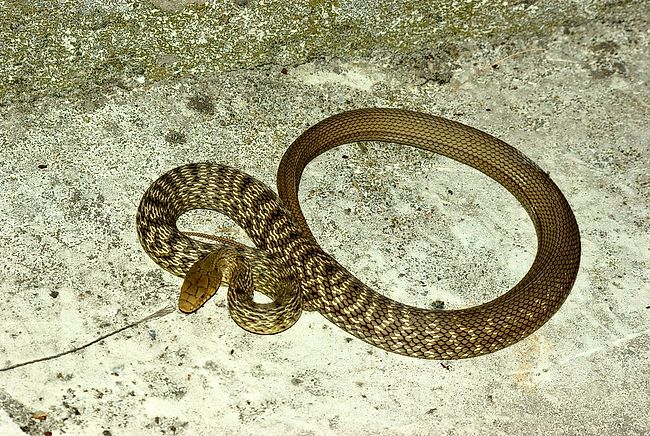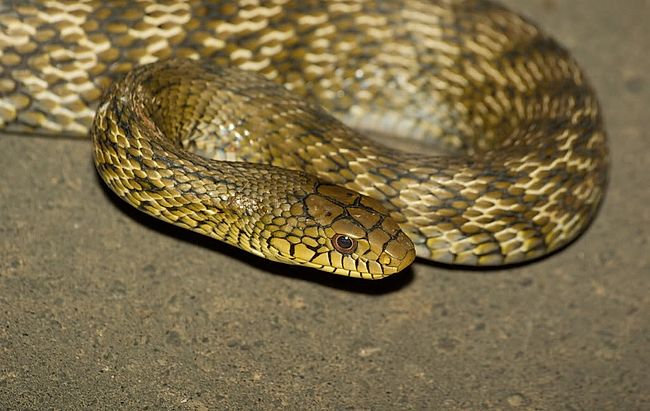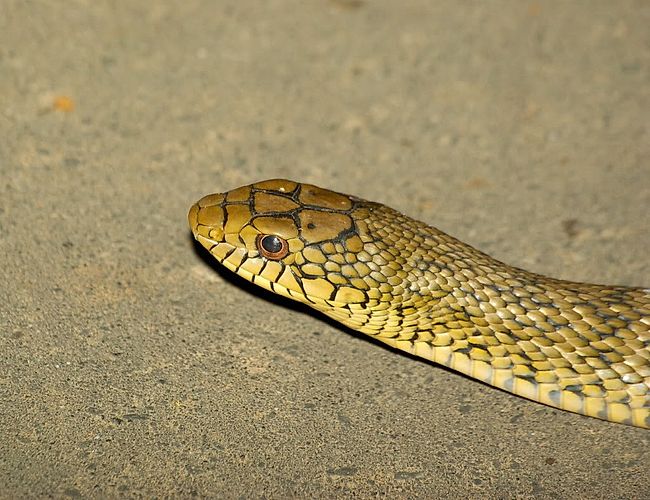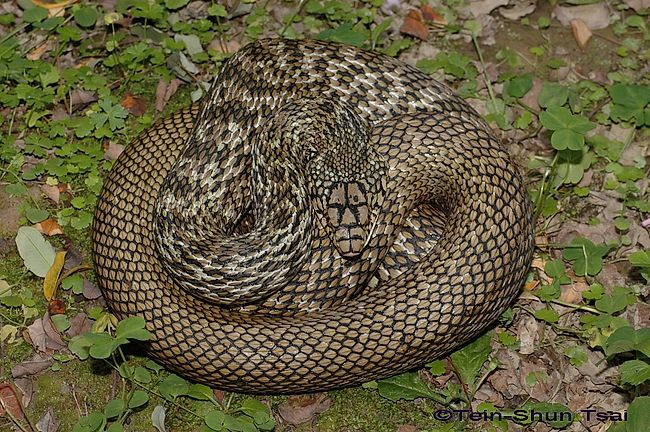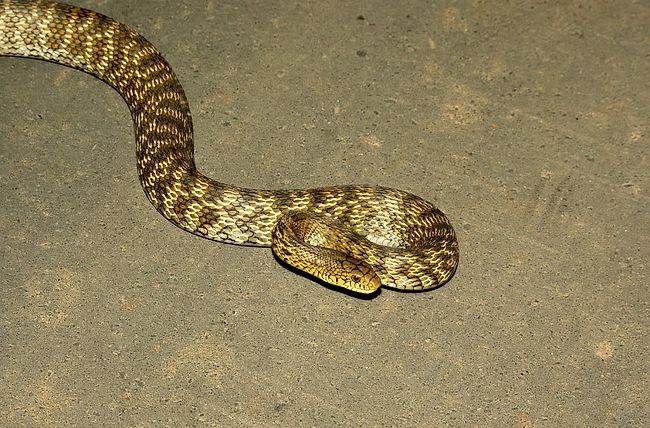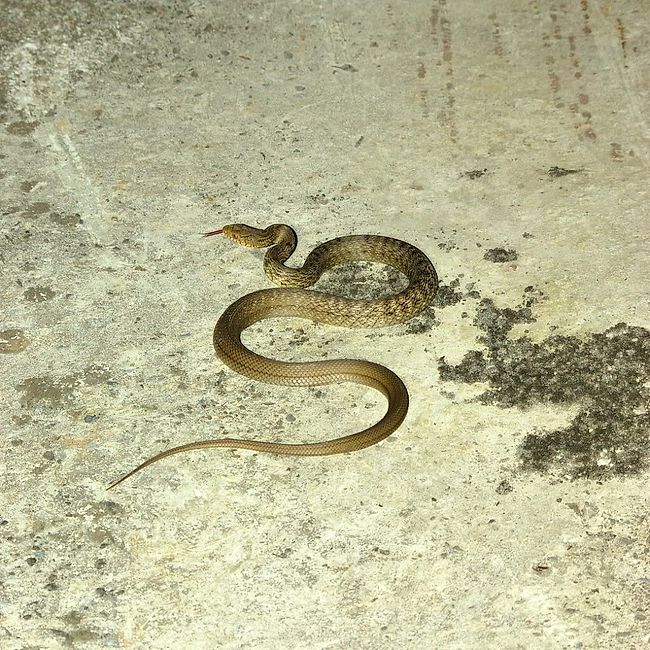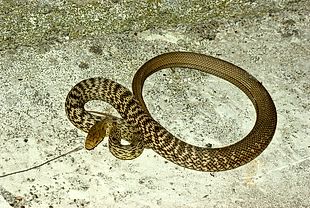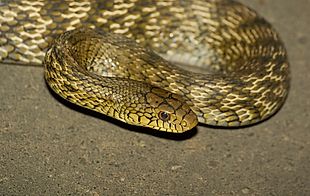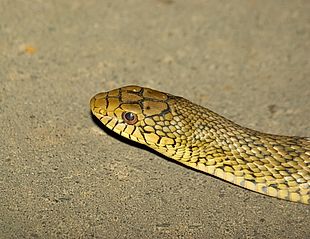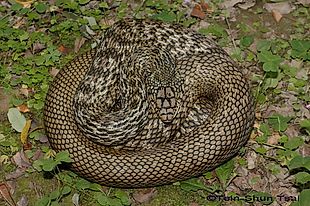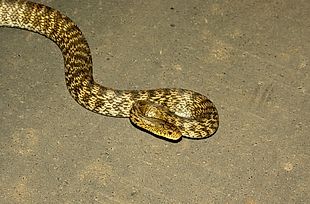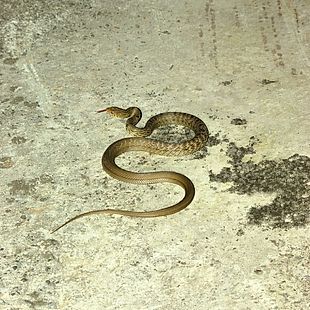Elaphe carinata carinata
King Ratsnake
臭 青公 (chou4qing1gong1)
Status: Not Protected
Non-venomous
Family
Colubridae, subfamily Colubrinae
Max. length
240 cm
Occurrence in Taiwan
Common throughout Taiwan and Orchid Island, up to 2000 m altitude.
Global Distribution
N. Vietnam (Hong River), Taiwan, C/South China (Gansu, Guangdong, Guangxi, Fujian, Zhejiang, Anhuei, Sichuan, Yunnan, Guizhou, Henan, Hebei, Hunan, Hubei, Jiangxi, Jiangsu, Shanxi, Shandong, Shaanxi), Japan (Ryukyu islands).
Description
Large snake;
total length up to 240 cm. There are 17-25 (21-25 at mid-body) rows of
scales, which are heavily keeled except for those in the first or second
rows. Head is elongate, slightly triangular; body is moderately heavy or
stout; tail is long. Eye is large; iris is light brown to rusty brown,
dappled with very fine flecks of dark brown and pupil is round to
vertically oval, jet black, surrounded by ring of golden orange. Tongue is
flesh-colored to red, with stem usually red and fork tips dark gray to
black. Upper head is olive gray to olive brown, and its dorsal shields are
distinct due to black pigment in sutures or along margins. Upper body is
olive yellow to olive brown, and most scales are distinct due to black
pigment on margins. Some individuals are uniform in color, however
others possess ill-defined cross markings on back or ill-defined bands due
to combination of scales with black margins and areas with black skin
between scales, and in other areas white skin may show between scales.
Posterior half of upper body and all upper tail are more uniform in
appearance. Ventral head is white to cream; lower labials are usually well
marked with black pigment on anterior margins. Ventral neck is cream white
to light gray, and pigmentation of irregular size and shape is
progressively greater and more intensive toward mid and posterior part of
ventral body while spots on outer quarter or third of the ventrals tend to
form broken longitudinal lines. Anal scale is divided and subcaudals are
paired. In the young the head may be less distinctly marked than in
adults. There is a minimum of black pigment along sutures of head shields
and the body scales may lack the black margins so characteristic to
adults. Some young individuals have dark cross bands anteriorly along the
vertebral line, and one or two light brown longitudinal stripes on sides
of body and extending onto tail while the ventrals may have little or no
pigment.
Biology & Ecology
E. c. carinata is one of the largest and heaviest snakes in Taiwan and venerated by many farmers
for its legendary rat-killing prowess. Some farmers, however, scared by the snake's formidable threat
behavior and overestimating its danger, often kill the snake on sight.
A diurnal or nocturnal snake, E.c. carinata inhabits shrub and wooded areas as well as agricultural areas,
and is often found in open fields, meadows, rice paddies and even farmhouses. It mates in spring; females
produce 8-14 eggs of approximately 5x3 cm per clutch in summer and habitually protect them. It preys
extensively on mice, birds, bird eggs or frogs, and sometimes on grasshoppers, beetles, lizards or snakes.
In fact, it prefers snakes to pretty much everything else, even venomous ones such as cobras,
kraits and habus. While it is not known whether it is completely immune to the venom of these
species, it certainly appears highly resistant against it.
In the wild it is active and moves quickly. It is vicious, strikes readily and attempts to bite;
some individuals held in captivity for months remain aggressive and cannot be handled with ease.
This snake has well-developed anal glands that can emit a very nauseous secretion.
In Taiwanese snake restaurants, E. carinata is the most commonly found species on the menu.
Fortunately, due to a number of developments, the number of snake eateries in Taiwan has now
dwindled considerably.
Etymology
The common English name "King Ratsnake" refers to its habit of eating other snakes.
"The generic name Elaphe is derived from the Greek word elaphos which means "stag".
Unfortunately, Leopold Fitzinger (1833) failed to give a reason why he chose this name.
One could guess that it refers to the antler-like marking on the head of the type species
Elaphe quatuorlineata sauromates, which also occurs in many other species." (Source)
Carinata is Latin for "keeled" and refers to the snake's scalation.
The Chinese name 臭青 公/母 (chou4qing1gong1/mu3) means "Stinking God/Goddess" and refers
"to this species' highly developed post-anal glands, that when picked up are frequently emptied,
with a very strong, bad odor". (Source)
Further Info






